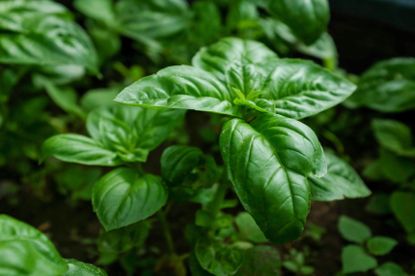Basil Temperature Tolerance - What Temperature Is Too Cold?
We love this herb, but basil’s temperature tolerance isn’t strong. It dislikes the cold and doesn’t like too much heat. The lack of basil’s cold tolerance is challenging, but worth it.


BASIL TEMPERATURE TOLERANCE - WHEN IS IT TOO COLD TO GROW?
It isn’t as easy to grow as some of the other herbs, mostly because basil temperature tolerance is rather like Goldilocks’ penchant for the bed that is “just right”. How cold can basil tolerate? For that matter, how does basil do under the scorching rays of the sun? I love basil and include it in my garden every season. Keep reading to learn what temperature is too cold (or hot) for basil.
Is Basil Cold Hardy?
No, basil is not cold-hardy. Most types of basil hail from warm regions of Asia and Africa. This means that this tender herb suffers injury or death with the onset of frost.
Basil Hardiness Zone
Basil can be grown as a perennial in USDA zones 10-11 but for those in cooler climates, the herb can be grown from zone 4 and up.
In my experience in zone 6b, my basil is a goner by around the first week of October. I’ve usually either harvested all that I wanted by then, moved it inside, or started new plants indoors from cuttings.
Basil Cold Tolerance
So what temperature is too cold for basil? Basil really begins to suffer when temperatures drop into the 40s, (4 C) and by the first frost, is usually on its last legs. If you can time it correctly, you can save your basil however.
How to Care for Basil in Cold Weather
There are a few things you can do to care for your basil when colder temps are imminent. If your fall days are still warm but nighttime temperatures are dropping rapidly, you can cover your basil plants with burlap, an old sheet or blanket, but be careful not to break the delicate branches. Be sure to uncover the plant when the sun comes up and temps warm for the day.
You can also opt to bring your basil plant inside or take cuttings while the plant is still healthy and start them as new plants indoors. If you grow your basil inside, provide it with plenty of bright light; about 10 hours of light. You will likely have to supplement any window light with artificial grow lights.
Gardening tips, videos, info and more delivered right to your inbox!
Sign up for the Gardening Know How newsletter today and receive a free download of our most popular eBook "How to Grow Delicious Tomatoes."
Just be aware that your basil has a finite life cycle. It will die back eventually, even inside. But you will still get an additional couple of months of this delicious fresh herb.
As a last resort, when frost is looming, harvest all the leaves you can and then either dry them or my personal favorite, make a big batch of pesto for the winter. It can be frozen in ice cube trays and then once frozen, stored in a sealed plastic bag ready to add to your winter soups, stews and pastas.
Frequently Asked Questions
When Should I Cover My Basil Plants?
Basil is a tender perennial in all but USDA zones 10-11 so if you reside in an area that gets frost, yes, cover your basil plants. Remember to uncover them during the day as temperatures rise over 40 (4C). Covering them will extend their growing season a little bit longer.
Does Basil Like Hot Temperatures?
While basil is native to the warm sunny regions of Asia and Africa, it doesn’t like scorching hot temperatures. It prefers full morning sun. If you live in a warm area, try to give your basil light shade during the heat of the day. I plant it under the leaves of my squash where it gets filtered light or in a container that can be moved out of the hot sun at midday.

Amy Grant has been gardening for 30 years and writing for 15. A professional chef and caterer, Amy's area of expertise is culinary gardening.
-
 Urban Composting Guide: How To Compost In The Middle Of The City
Urban Composting Guide: How To Compost In The Middle Of The CityUrban composting does not have to be daunting. You can compost in the city, and maybe even try some urban worm composting!
By Mary Ellen Ellis
-
 Shrub Diseases And Pests To Watch Out For
Shrub Diseases And Pests To Watch Out ForShrub diseases and pests can be challenging. Learn how to recognize and eradicate them before they can present a danger to your plants.
By Susan Albert